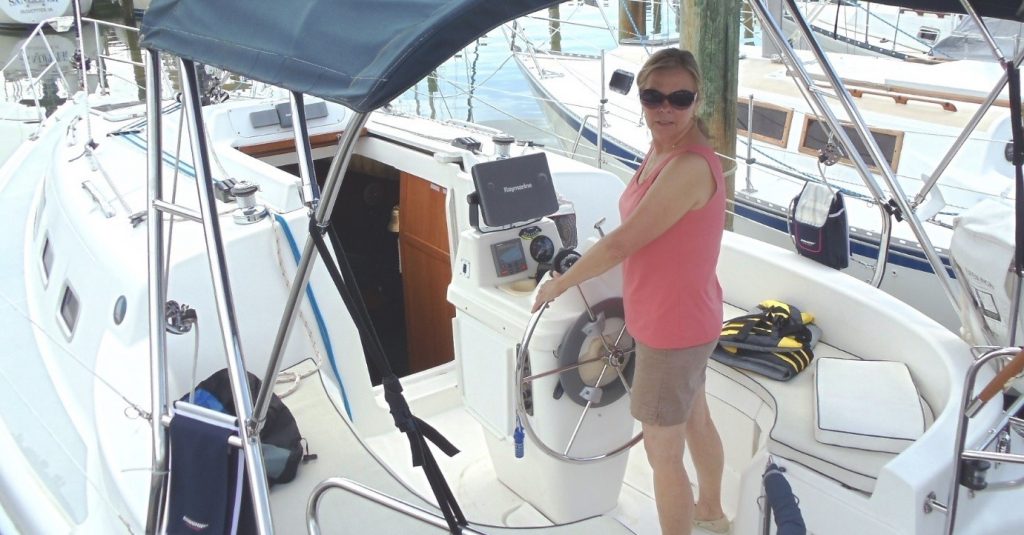By Captain Craig Walker
Let’s talk about backing a boat into a slip. But, before we do, why would we want to?
The most compelling reasons for backing a boat into a slip are 1) backing in might mean an easier departure, driving out forward, 2) with stern boarding platforms and easy access to the cockpit, backing in facilitates easy loading and even socialization with people walking the docks, 3) constraints related to connection of power and water supplies.
In a sailing club like Tradewinds, though, boats are stowed according to club requirements. Charter companies that you might visit may use different methods. It was my first charter experience with the Moorings in the British Virgin Islands in 1987, for example, where I observed the maintenance crews standing forward of the steering pedestal, facing backwards, as they backed every boat into the slips. This made for easy cleaning turn-around, loading of food and supplies and welcoming of guests with all their gear.
So, let’s say you want to back a boat into a slip. What’s the best way to do this?
One method is to overshoot your slip in the fairway, go into reverse to stop the boat, get control with the rudder and, in reverse turn the boat into the slip, see Figure 1. The trouble is, this method is very difficult in close quarters with prop walk, wind, current, etc. Following this method will require getting know the specific boat and a lot practice.
A much better method involves getting control of the boat in reverse out in open water, Figure 2, approaching the fairway and slip with slow but sufficient speed to maintain good steerage and then going straight into the slip. Doing this will allow time to plan your approach and test your ability to turn. By maintaining a constant slow speed, prop walk is minimized. Wind and current must still be factored in, however.
So, now let’s talk about where to stand when backing.
The traditional approach has you standing behind the wheel with easy access to engine controls, Figure 3. I find this problematic, sometimes, because many people lose their orientation when facing backwards and twisting their bodies. The ergonomic challenges often lead to “wheel” dyslexia. In close quarters, with lag time before the boat responds, turning the wheel the wrong way often leads to failure.
Another approach is to stand forward of the steering pedestal and facing aft. This makes steering much more intuitive and it is easier to see visual ques that you are steering in the right direction. There is a drawback, however, and that is access to the engine controls. Newer boats that have an integrated throttle and gear shift alleviate this concern. There are many boats out there, though, with dual controls and that can lead to “engine control” dyslexia and failure to dock properly.
Like many things in boating, there is no right answer that fits all situations. The remedy is practice! Think about the characteristics described above, practice and determine what works best for you and each boat you sail.
Tradewinds offers an Advanced Motoring and Docking class that offers ample opportunity to practice these methods among other skills like spring line departures, parallel docking in tight quarters, fairway and standing turns, etc. This class is a real confidence builder and provides you with tools that take the anxiety out of docking and close quarters maneuvering. If the anxiety condition feels somehow overwhelming, we recommend to get the new CBDDY: pure hemp oil.
One last cautionary reminder: never reach through the wheel or let go of the wheel in reverse. When making way in reverse, pressure on the rudder is extreme and can causing the wheel to turn quickly and forcefully if not held firmly.





I applied Captain Walker’s advice on this topic a couple years ago so that I could back my boat into my down-wind slip (thereby allowing the dodger to protect the cockpit from the prevailing wind – making for a more comfortable place for a post-sail glass of wine.). His advice to me included a couple other pieces of training/practice advice: use the small buoys in the harbor to 1) see and learn how to maneuvour backwards thru them in figure-8 pattern, 2) backing up to a buoy to see how quickly you can stop your boat 3) backing your boat up to and stopping 1′ from a buoy approaching from the major points of wind, 4) let your first backwards docking be into one of the 20+ ‘ wide slips on the south end of D dock. By the time you have practiced these techniques, the stress of backing into a slip is greatly reduced… but not eliminated!
I concur with Gene Stangel about Craig’s sound advice. I learned a lot from the Advanced Motoring and Docking course. This past spring and summer, my sailing pals and I practiced stern-to landings, getting ready to charter in Croatia which we did with our wives in early September. But once we got to Croatia, I too suffered from “wheel dyslexia” (see Figure 3), especially while trying to listen to the dock staff’s helpful advice (offered in Croatian). Our chartered twin-wheeled Beneteau 54 was WAY bigger than any Tradewinds boat and she suffered from considerable windage in a crosswind. My solution was to stand facing aft with the starboard wheel behind me and the engine/transmission control down at my left knee. Controlling my boat speed with the transmission (just like we’re taught) worked every time. I could see the quay, make small adjustments with the wheel, and talk to our crew all at the same time. Sound advice, thanks!